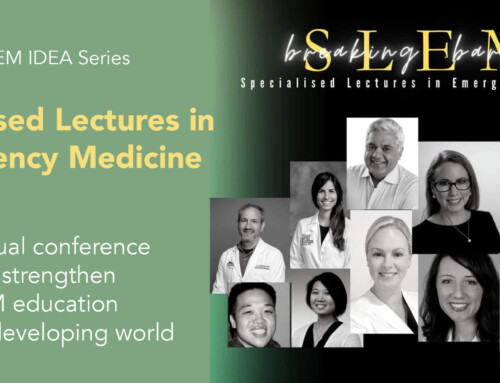 First and foremost, international emergency medicine (IEM) is a big tent. We’ve got clinicians with an interest in tropical medicine and trauma, systems experts, inventors, educators, missionary families, public health experts, thrill-seekers, and policymakers. A disaster response specialist who has a “go bag” packed at all times ready for deployment belongs in this tent, as does an epidemiologist based in the U.S. who analyzes data on cholera outbreaks in refugee camps. Because it’s a relatively new specialty there is the occasional squabble about what does and does not constitute IEM, but generally we agree that we are working together to improve the state of health for people in our world. Our specialty allows us to work in a multitude of settings and clinical environments, something that no other specialty can do.
First and foremost, international emergency medicine (IEM) is a big tent. We’ve got clinicians with an interest in tropical medicine and trauma, systems experts, inventors, educators, missionary families, public health experts, thrill-seekers, and policymakers. A disaster response specialist who has a “go bag” packed at all times ready for deployment belongs in this tent, as does an epidemiologist based in the U.S. who analyzes data on cholera outbreaks in refugee camps. Because it’s a relatively new specialty there is the occasional squabble about what does and does not constitute IEM, but generally we agree that we are working together to improve the state of health for people in our world. Our specialty allows us to work in a multitude of settings and clinical environments, something that no other specialty can do.
If you have ever considered getting involved in IEM, or just want to know what on earth your colleagues are doing all that time when they disappear from the department and return a month later sunburned with red mud caked on their shoes, here is an overview of just some of the possibilities:
Direct Clinical Care
Direct clinical care is at the core of what we do in emergency medicine, and by translation, IEM. Clinical skill is the foundation, and without it you cannot teach others. Some physicians have done special coursework in treating diseases endemic to the populations where they practice (a diploma in tropical medicine, for example), but many learn through self-study or on the job. There is a growing recognition that expertise in the management of traumatic injuries and non-communicable diseases are a growing need in the developing world.
The exchange of knowledge is a two-way street; many physicians who have worked internationally – particularly in resource-limited settings – find that their physical exam skills, ability to think creatively and improvise solutions, and take care of critically ill patients are much improved by working overseas. Additionally, we are able to contribute to the training and education, building capacity in the local community.
Education
“Give a man a fish, feed him for a day. Teach him how to fish, feed him for life.”
Training and education of local providers and faculty are the keys to creating a sustainable improvement in care. Emergency Medicine residency programs have been growing in number and size around the world as our specialty matures. As local trainees graduate from programs, they become the faculty teaching the next generation. Opportunities also exist to provide valuable training to prehospital providers, nurses, and more. You have done your job in a global health program when you are no longer needed because a previous trainee can do it better than you ever did.
Disaster Response
When disaster inevitably strikes, EM physicians are at the front lines of care both domestically and internationally. Working in disaster settings is extremely challenging but equally rewarding, as you have the opportunity to put your skills to maximum use. Many EM physicians are on the rosters of aid organizations and ready to answer the call when needed. This type of work generally involves shorter term trips on very short notice to any corner of the world that help is urgently needed.
Research
This is a fundamental part of all of medicine and IEM is no different. Large investments are frequently made both in time and money to improve health care systems in low and middle income countries. Measuring outcomes of different interventions and approaches is how we learn from our mistakes and improve the systems around us. Local involvement is the first step for any IEM research project which will help you truly understand the gaps and needs in an area.
Advocacy
Just as emergency physicians are at the forefront of domestic healthcare policy, they should be globally as well. We understand the needs of society better than most as we work 24/7 at the front door of medicine, without requiring an appointment, confirmed payment, or a certain type of disease or injury. It is our responsibility to inform our leaders and decision makers on the policy decisions that will create the best access and the highest quality of care for our patients. This extrapolates internationally, where it remains our responsibility to give a voice to those that may otherwise not be heard.
Systems Development
A good healthcare system requires more than just providers, as we can do very little without our nurses, techs, specialists, and clerical staff. Not just that, but we also need buildings, electricity, clean water, and secure facilities. These systems often improve in a “one step forward, two steps back” fashion. For example, there are emergency departments internationally that have point of care ultrasound but no gloves, or a video laryngoscopy system but no blades. There is tremendous work to be done in creating the systems that will allow patients, providers, and trainees to succeed.
Emergency physicians are perfect for the job
Anything, anywhere, anytime – isn’t that what we all signed up for? Our diverse interactions with patients and other providers within our healthcare system make us well-suited to work in settings where perhaps the sub-sub-sub-specialist isn’t just a quick phone call away. Nobody has their finger on the pulse of society and the system like we do, and because of this, nobody is better positioned to inform the health care policy decision makers. In a way, emergency medicine is almost designed for global health because of this daily diversity. Likewise, the shiftwork aspect of EM care gives us the unique opportunity to make time for overseas work. We don’t have a pager, or a patient roster, and there is often departmental support for allowing us to “bank” additional shifts to be used for extended trips away.
How to get involved
There are a ton of ways to get involved on all different levels. Don’t be put off if you haven’t had a lot of experience yet – an open mind, a sense of curiosity and humility, and a willingness to push beyond your comfort zone will all go a long way.
- If there is a provider in your department already working in the field, the easiest way is to reach out to them. If not, look towards your local academic institution and see if they have a global health division. They may be able to facilitate time spent with their partner sites and organizations.
- If you are looking for a short term assignment, you can apply to one of the many non-governmental organizations (NGOs) that are out there and offer your services. When looking, take care to find an organization that has a sustainable mission and overhead costs that are reasonable, ensuring most funding goes towards the mission.
- If you are looking to take a deeper dive into the field, then take a look at Médecins Sans Frontières (MSF) International or International Medical Corps (IMC) as well as several other groups.Emergency physicians are highly desired for long term field assignments due to our diverse skill set and adaptability. A minimum assignment for one of these organizations would be at least 6-9 months.
- If you are looking to shift your career into the field full time, then consider looking at the many United Nations organizations out there that regularly post positions online. You may take a pay cut, but the experience you will gain and impact you will have will likely make up for it.
What does an IEM Fellowship entail?
If you are a current resident, looking into an IEM fellowship is a great way to get the experience and networking that will prepare you for a career in the field. There are a lot of models. The majority are two years long and incorporate a graduate degree, most commonly an MPH. Some programs will allow you to do a one-year fellowship if you already hold a master’s degree. Typically you work a set number of clinical shifts in the emergency department while engaging in research activities. Depending on the fellowship, you may rotate at an established site abroad or through several shorter term assignments. Fellows will generally take humanitarian and field training courses put on by the International Committee for the Red Cross and other organizations as well. For more information on IEM fellowships, check out www.iemfellowships.com.
Image credit: (c) Can Stock Photo






